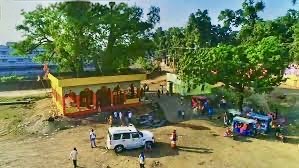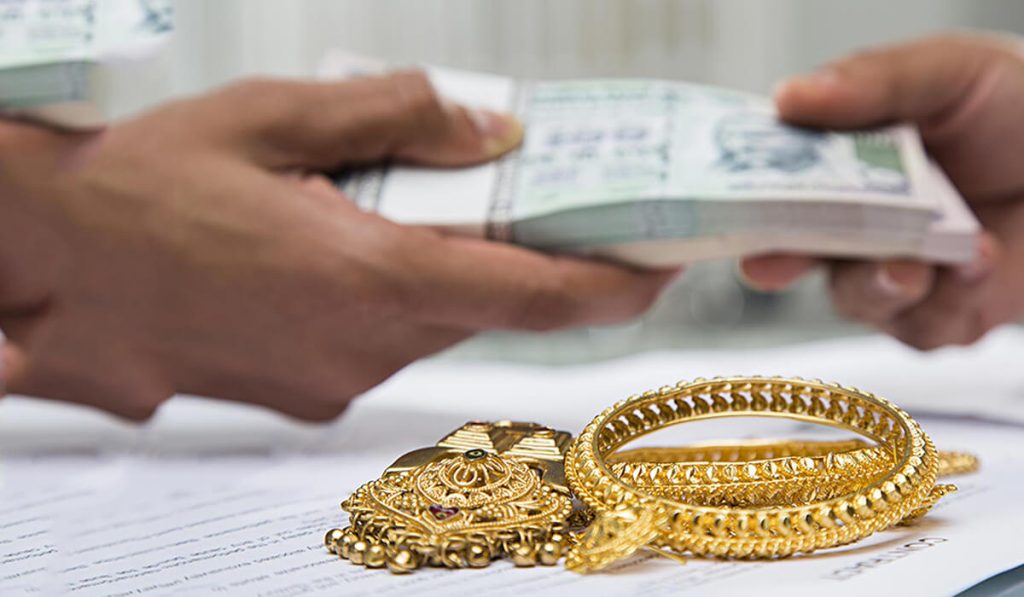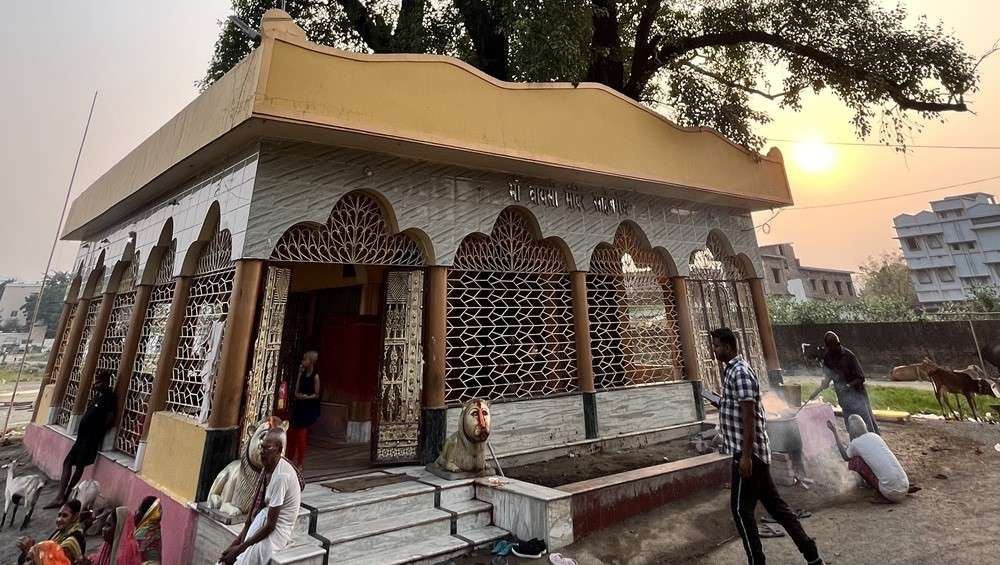In the culturally rich landscape of Sahibganj, Jharkhand, amidst lush greenery and tribal communities, lies a site of profound reverence — Maa Baisi Sthan. This sacred temple is dedicated to the Gram Devi (village goddess) of the region and holds a special place in the spiritual and cultural fabric of local society.
Believed to be the guardian deity of Sahibganj, Maa Baisi embodies protection, fertility, justice, and village prosperity. Her temple, humble yet powerful in aura, draws countless devotees — not just for rituals but for a sense of belonging to something ancient and divine.
Table of Contents
Significance of Maa Baisi Sthan: The Gram Devi of Sahibganj
Maa Baisi Sthan holds immense cultural and spiritual significance as the Gram Devi (village goddess) of Sahibganj and its surrounding tribal villages in Jharkhand. She is not just a deity to be worshipped — she is a living force, protector, and ancestral spirit whose presence governs the social, spiritual, and ecological rhythms of the region.
1. Spiritual Guardian of the Land
Maa Baisi is believed to be the protector of twenty-two villages (hence “Baisi”). Villagers turn to her in times of natural disasters, crop failures, diseases, and personal crises. Her blessings are considered vital for:
Good harvests
Safe childbirth
Rain during drought
Protection from evil or black magic
2. Folk Shakti – Tribal Form of the Divine Mother
Unlike classical Hindu deities depicted in stone idols, Maa Baisi is often symbolized by:
A mound or stone smeared with vermilion (sindoor)
Decorated with red cloth, bangles, flowers, and diya lamps
This connects her deeply with Santhali, Pahadi, and Munda tribal traditions, where the divine feminine is formless, natural, and elemental.
3. Dispeller of Injustice
Locals treat Maa Baisi as a moral arbiter. In cases of unresolved village disputes, people pledge their honesty before her. If someone lies before Maa Baisi, it is believed divine retribution will follow. This makes her temple an informal community court of sorts.
4. Feminine Energy and Fertility
Women—especially those facing fertility issues—come barefoot to pray, tie sacred threads, and vow offerings if blessed with children. Married women also pray for:
Husband’s longevity
Protection of family
Household prosperity
5. Ecological and Cultural Identity
The temple is surrounded by sal trees, sacred groves, and natural altars, symbolizing her deep connection with the land. During Sarhul and Sohrai festivals, villagers offer forest flowers, rice beer, and leaves—highlighting her role as a nature deity and earth mother.
6. Emotional and Cultural Anchor
For the people of Sahibganj, Maa Baisi is not distant or abstract — she is part of everyday life. Her presence is invoked during:
Naming ceremonies
Wedding rituals
Community gatherings
Cultural performances (tribal dance, songs)
Location & Accessibility
Maa Baisi Sthan is located within Sahibganj district in the Santhal Pargana region of Jharkhand. It is easily accessible from Sahibganj town via auto-rickshaws and small vehicles. The area is surrounded by serene fields, forests, and tribal villages — offering a backdrop that perfectly complements the spiritual calm of the temple.
Meaning Behind “Baisi Sthan”
“Baisi” literally means “twenty-two” in Hindi. Locals believe the name signifies either:
The presence of 22 forms or manifestations of the Goddess in this region, or
That 22 villages collectively worship this Devi, considering her the protector of the land.
This etymology reinforces the collective reverence of Maa Baisi across community lines — tribal, rural, and urban.
Historical & Mythological Origins
While no formal written scripture defines Maa Baisi’s origin, oral traditions and local lore fill the gap.
The deity is believed to be a tribal form of Shakti, deeply rooted in Santhali and Pahadi beliefs.
Some scholars interpret Maa Baisi as a localized incarnation of Goddess Durga or Kali, adapted into the cultural and ecological context of the Santhal heartland.
The temple site is said to be self-manifested (Swayambhu), and villagers claim that during droughts or crises, special prayers to Maa Baisi have miraculously resolved situations.
Deity Form & Worship Practices
Inside the temple, Maa Baisi is not represented in a conventional anthropomorphic idol, but often as a stone symbol (shila) or sacred mound adorned with vermilion, bangles, red cloth, and marigold flowers. This aligns with folk and tribal traditions, where the form is symbolic, and the energy is more abstract than sculptural.
Key Worship Rituals:
Red Chunari (veil) and Sindoor are offered by married women for marital harmony.
Goat sacrifice is still practiced during some tribal festivals, although it’s slowly being replaced with symbolic rituals.
Earthen lamps (diyas), rice, turmeric, and mustard oil are common offerings.
Devotees often tie threads or leave stones as votive symbols after their wishes are fulfilled.
Cultural Role: Gram Devi and Beyond
Maa Baisi is not just a religious figure but a village guardian and community judge.
During village disputes, elders often vow truthfulness by invoking Maa Baisi — making her temple a social justice center.
Agricultural cycles, monsoons, childbirth, and marriage — all revolve around her blessings.
In Santhal and Pahadi communities, Maa Baisi is invoked during seed-sowing festivals, harvest celebrations, and rites of passage.
Maa Baisi Sthan Festivals and Rituals: Celebrations of Faith and Tradition
The festivals and rituals of Maa Baisi Sthan are an integral part of Sahibganj’s spiritual life, weaving together tribal customs, folk traditions, and Hindu elements. These vibrant celebrations not only honor the Gram Devi (village goddess) but also strengthen the bond between the people, nature, and ancestral beliefs.
Major Festivals Celebrated at Maa Baisi Sthan
1. Navratri (Chaitra & Sharadiya)
Navratri is one of the most important festivals celebrated at Maa Baisi Sthan, observed twice a year:
Chaitra Navratri (March–April)
Sharadiya Navratri (September–October)
Rituals Include:
Kalash Sthapana (sacred pot installation) on Day 1
Daily aarti and bhajan-kirtan at sunrise and sunset
Women offer red chunari, sindoor, bangles, and rice to Maa Baisi
Kanya Puja on the 8th or 9th day — where young girls are fed and worshipped as the living form of the goddess
Community feast (bhandara) is held on Ashtami or Navami
Navratri is also when local tribal dancers perform Jhumar and Santhali Naach, turning the temple courtyard into a joyful expression of devotion.
2. Sohrai Festival (Harvest Festival)
Celebrated during October–November, Sohrai is a tribal harvest festival where Maa Baisi is worshipped as the goddess of agriculture and fertility.
Key Rituals:
Worship of cattle and tools used for farming
Families offer newly harvested grains, pumpkins, and sal flowers to the goddess
Sacred animal offerings (sometimes symbolic in modern times)
Homes are decorated with Sohrai tribal art, and the temple is adorned with mud patterns and natural dyes
3. Sarhul Festival
Held in spring (March–April), Sarhul is a festival of nature worship among the Santhal and Munda communities.
Rituals Involve:
Worship of sal trees and mother earth
Offering rice beer (handia), flowers, and forest leaves to Maa Baisi
Traditional tribal drumming and dancing
Priests (Pahans) and elders perform ancestral prayers and invoke the goddess for rain and agricultural prosperity
4. Deepawali & Kali Puja
Though Maa Baisi is not formally Kali, her Shakti aspect is honored during Diwali through Kali-style puja.
Key Highlights:
Night-long aarti, chants, and diya lighting
Offerings of sweets, oil, and mustard seeds
In some years, tantric rituals are performed by local sadhaks in secluded areas of the temple
Common Rituals Performed Year-Round
1. Vow Fulfillment (Mannat Puja)
Devotees come to Maa Baisi Sthan to fulfill personal vows or “mannats” after their wishes come true — such as childbirth, exam success, health recovery, or marriage.
Offerings: Earthen pots, bangles, red cloth, incense sticks, coconut, and rice
Some tie sacred threads to trees or place a stone in a sacred circle to mark their fulfilled vow
2. Animal Sacrifice (Now Largely Symbolic)
Historically, goat sacrifice was practiced during Navratri and Sohrai. Today, many followers opt for symbolic coconut-breaking instead. However, some tribal families still follow the traditional method as part of ancestral rites.
3. Sanctum Offerings
Devotees bring:
Sindoor (vermilion)
Red chunari
Mustard oil lamps (deepak)
Dried turmeric, cloves, bangles, and coins
Rice grains or puffed rice (murmura)
All these are placed at the base of the Devi mound or sacred shila, followed by a circumambulation (parikrama) of the shrine.
4. Devotional Songs & Dances
On festive nights, local women and children perform:
Chhota Nagpuri folk songs
Santhali drumming and chanting
These cultural expressions are both spiritual offerings and community bonding rituals.
5. Healing & Protection Rituals
People believe Maa Baisi can cure unknown illnesses, protect from evil spirits, and ensure domestic peace. Traditional healers (ojhas) visit the temple and perform minor exorcism rituals, especially during:
Amavasya (new moon nights)
Solar/lunar eclipses
Shravan month Mondays
Community and Cultural Importance
These rituals are not just religious but socially binding events. They:
Create space for inter-generational knowledge exchange
Encourage youth participation through folk art
Preserve tribal languages, customs, and oral histories
Promote unity between tribal and non-tribal groups through shared devotion
Summary Table of Major Festivals
| Festival | Season | Key Rituals & Offerings |
|---|---|---|
| Navratri | Mar–Apr / Sept–Oct | Daily aarti, kanya puja, bhandara, dance |
| Sohrai | Oct–Nov | Harvest worship, tribal art, animal offerings |
| Sarhul | Mar–Apr | Nature worship, rice beer, sal flower offerings |
| Diwali | Oct–Nov | Lamp lighting, tantric puja, sweets |
Visiting Maa Baisi Sthan in Sahibganj: A Sacred Journey Through Devotion and Culture
Planning a visit to Maa Baisi Sthan, the revered Gram Devi temple in Sahibganj, Jharkhand, offers more than just a spiritual experience—it’s a journey through tribal traditions, rural serenity, and timeless devotion. Whether you’re a pilgrim, a cultural explorer, or a local history enthusiast, this guide covers everything you need to know.
Where Is Maa Baisi Sthan Located?
Maa Baisi Sthan is situated in the Sahibganj district of Jharkhand, within the Santhal Pargana division, a region known for its tribal heritage and deep spiritual roots.
Village: Near or within Sahibganj town or adjacent tribal hamlets
Coordinates: Approx. 25.25° N, 87.65° E (subject to exact site variation)
Nearby Landmark: Often near Sal forests and rural settlements
How to Reach Maa Baisi Sthan
| Mode | Details |
|---|---|
| By Road | Easily accessible from Sahibganj town (within 5–8 km radius) via autos, taxis, or even walking |
| By Rail | Sahibganj Junction is the nearest railway station (well-connected to Bhagalpur, Kolkata, and Patna) |
| By Air | Nearest airport: Deoghar Airport (220+ km) or Bagdogra Airport (longer route) |
| By Local Transport | Shared autos and electric rickshaws ply frequently from the town center |
Tip: If traveling during a festival like Navratri or Sarhul, start early to avoid crowd congestion.
What to Expect on Arrival
Visiting the temple isn’t just about entering a structure—it’s a ritual of transition. Here’s what you’ll typically experience:
Temple Layout
Open courtyard, surrounded by trees
Sanctum: Contains a sacred mound or shila (stone) symbolizing Maa Baisi
Decorated with sindoor, bangles, red cloth, diya lamps, and prayer flags
An open space used for festivals, dances, and community rituals
Ritual Practices for Visitors
Remove footwear before entering temple premises
Offer red chunari, incense sticks, flowers, coconut, and sweets
Light a mustard oil lamp and walk around the sanctum (parikrama)
For personal wishes (mannat), tie a sacred thread to a tree or place a stone in the offering circle
Women pray for fertility, family harmony, and protection
Offer thanks through donations or simple prayers once your wish is fulfilled
Best Time to Visit
| Season | Reasons to Visit |
|---|---|
| Navratri (Mar–Apr & Sept–Oct) | Most vibrant celebration, cultural programs, Kanya Puja |
| Sarhul (March/April) | Tribal nature worship, sal flower offerings |
| Sohrai (Oct–Nov) | Harvest rituals, tribal art displays |
| Diwali/Kali Puja | Tantric-style rituals and devotional lamp lighting |
| Shravan Month (July–Aug) | Mondays are highly auspicious for Shakti worship |
Nearby Facilities & Amenities
| Type | Availability |
|---|---|
| Accommodation | Lodges and guesthouses in Sahibganj town (basic to mid-range) |
| Food | Local restaurants and tea stalls nearby, especially during festivals |
| Shops | Small stalls sell puja items, flowers, and souvenirs |
| Restrooms | Limited public restrooms near temple—use facilities in town for comfort |
Travel Tip: Bring water, snacks, and any personal hygiene items, especially during peak seasons.
Photography & Cultural Etiquette
Photography is allowed outside the sanctum, but ask permission before clicking inside or during rituals
Dress modestly — avoid shorts or sleeveless attire inside the premises
Don’t interrupt tribal performances or sacred rites
Avoid plastic usage — bring a cloth bag for offerings
Suggested Itinerary (1 Day Visit)
| Time | Activity |
|---|---|
| 8:00 AM | Arrive at Sahibganj & enjoy breakfast |
| 9:00 AM | Travel to Maa Baisi Sthan temple |
| 10:00 AM | Perform rituals, offer prayers |
| 11:30 AM | Walk around village area, observe local art/culture |
| 1:00 PM | Lunch at a local dhaba |
| 2:00 PM | Optional visit to nearby temples like Shivgadi Dham or Binduwasini Mandir |
| 5:00 PM | Return to Sahibganj town center or your hotel |
Nearby Attractions to Combine
Shivgadi Dham Temple – Waterfall cave temple of Shiva (~8 km)
Binduwasini Temple – Famous Shaktipeeth site
Moti Jharna Falls – Scenic picnic spot
Rajmahal Hills – Rich in paleontological and geological significance
Why Visit Maa Baisi Sthan?
Experience authentic tribal Shakti worship in a living cultural setting
Participate in rituals rooted in oral traditions and folk ecology
Discover rare rural spiritual heritage unknown to mainstream tourism
Connect with the sacred feminine through an earth-bound goddess
Enjoy the natural and cultural peace that modern temples often lack
Local Beliefs & Miracles
Residents of Sahibganj recount numerous miraculous stories tied to Maa Baisi:
A sick child recovering after being offered Maa’s holy soil (mati) on the forehead.
Rainfall arriving after collective ritual chanting and offerings during a dry spell.
Women unable to conceive visiting the shrine barefoot and later returning with newborns as thanksgiving.
Such stories reaffirm Maa Baisi as a living deity, one who responds with grace and force.
Architecture & Temple Premises
The temple architecture is simple — a single shrine with a conical roof, surrounded by banyan trees and prayer flags. The complex includes:
A wishing stone circle
A sacrificial altar (balidan sthal)
A drum pavilion where Santhali women sing during processions
More than design, it is the energy and earthy aesthetic that define the sanctum’s spirituality.
Community Role & Modern Relevance
In modern times, Maa Baisi continues to:
Be a symbol of feminine strength and ancestral connection.
Unify diverse caste and tribal identities through shared devotion.
Inspire youth festivals, school cultural programs, and local heritage conservation.
NGOs and tourism departments have begun to promote ethno-spiritual tourism in Sahibganj with Maa Baisi Sthan as a centerpiece.
Travel Guide: How to Visit
| From | Route | Approx. Distance |
|---|---|---|
| Sahibganj Town | Local autos/taxis | 5–8 km |
| Ranchi | Via train or NH133 | 300+ km |
| Bhagalpur | Road via Pirpainti | ~90 km |
Best Time: Navratri, Diwali, or Sarhul festival seasons
Travel Tips:
Carry your own water/snacks.
Respect tribal customs, especially dress and footwear codes inside the sanctum.
Avoid plastic — the area is ecologically sensitive.
Final Thoughts
Maa Baisi Sthan is more than a shrine — it is a bridge between the natural and supernatural, the tribal and Hindu, the ancestral and contemporary. For locals, she is mother, protector, healer, and justice-giver. For visitors, it offers a rare glimpse into Jharkhand’s hidden spiritual geography.
Whether you’re a pilgrim, cultural explorer, or spiritual seeker, Maa Baisi welcomes all with open arms and earth-rooted divinity.
Summary
Maa Baisi Sthan
📍 Location: Sahibganj, Jharkhand
🛕 Type: Tribal-Hindu Gram Devi Temple
🌸 Festivals: Navratri, Sohrai, Sarhul, Kali Puja
🧭 Significance: Gram Devi, fertility, justice, prosperity
✨ Uniqueness: Symbolic idol, tribal rituals, community healing center












